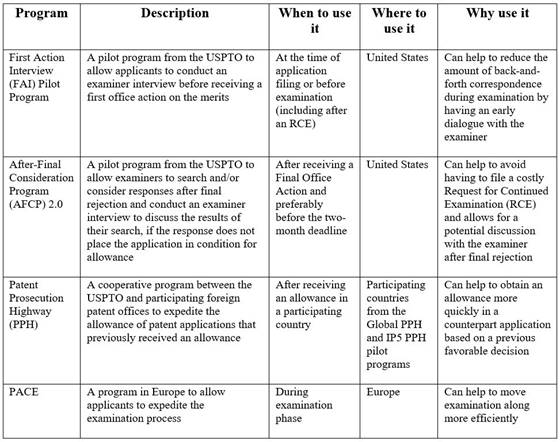
This article originally appeared on Law360 and is republished here with permission.
Even prior to the COVID-19 pandemic, many corporate legal departments were operating with constrained financial budgets. The COVID-19 pandemic has only exacerbated this issue. So what can corporate patent counsel do to reduce expenses but still maintain a strong and valuable patent portfolio? Below are five cost saving measures to consider in the wake of COVID-19.
1. Reevaluate foreign patent strategy.
One way that corporate patent counsel can reduce expenses while maintaining a valuable patent portfolio is to reevaluate their company’s foreign patent strategy. This should be a two-part analysis that includes a review of the company’s current foreign patent portfolio and a reassessment of the company’s foreign filing strategy moving forward.Review current foreign patent portfolio.
Corporate patent counsel should review all active foreign patents and pending applications in the company’s portfolio to determine which assets are no longer strategically important to the business. Foreign patents and applications that no longer align with the company’s current business strategy should be abandoned or potentially sold/licensed, which could provide a potential revenue stream.
Patent counsel should also determine which assets are too expensive to maintain relative to the strategic value that they may provide to the business. If it does not make financial sense to continue maintaining a foreign patent or application in a particular jurisdiction, then the applicable asset should be potentially abandoned or sold.
For example, the scope of potential patent protection may be narrow, examination may be going on for an extended period of time with little or no progress, the corresponding product or service volume may be low, or there may be few competitors in the relevant jurisdiction to justify the expense of maintaining the asset.
Additionally, many foreign jurisdictions, such as Europe and Canada, require annuities to be paid at regular intervals during both the pendency of a patent application and after the application grants as a patent in order to maintain the asset. These annuities can increase substantially over the lifetime of a patent, so it is a good idea to regularly review, and potentially prune, some of the older foreign patents from the company’s portfolio to free up financial resources.
It is also worth noting that if a third-party provider is used to pay annuities for foreign patents or applications in the portfolio, then patent counsel should determine if there are any upcoming payment deadlines and evaluate the relevant asset to determine if it can be abandoned or sold before incurring the annuity expense. This is especially true if annuities are scheduled to be automatically paid by the third-party provider, which could go unnoticed.
Reassess foreign filing strategy.
In addition to reviewing the company’s current foreign patent portfolio, corporate patent counsel should also reassess the company’s foreign filing strategy moving forward. For example, corporate patent counsel should determine if there are any opportunities to reduce the number of foreign jurisdictions that are typically pursued for a particular patent family.
This may include jurisdictions previously determined to be relevant but that no longer are due to, for example, a change in business strategy, a change in the competitive landscape, a change in sales volumes in a particular country or a change in a manufacturing location. In this manner, the resources that may have been spent on nonvaluable jurisdictions can be redeployed to use on more strategic assets, e.g., bolstering the U.S. portfolio for critically important technology, etc.
Corporate patent counsel should also consider the potential cost savings of direct filing in foreign countries instead of indirect and/or delayed filing, e.g., via the Patent Cooperation Treaty. Since the potential cost savings may vary depending on jurisdiction, these types of inquiries should be raised to outside counsel to determine the best approach.
Lastly, corporate patent counsel may consider pursuing utility model applications in certain countries, e.g., China, Germany, etc., instead of regular patent applications in order to reduce expenses. Generally speaking, utility models cost considerably less and can be registered and granted much more quickly than regular patent applications, since these types of applications do not undergo as stringent of an examination process.Utility models, however, may have different enforcement mechanisms than regular patents, depending on the jurisdiction, so it is important to understand both the benefits and risks of pursuing a utility model instead of a regular patent application before going in that direction.
2. Utilize compact prosecution strategies.
Another way that corporate patent counsel can reduce expenses is to utilize or ensure that their outside counsel is utilizing various patent prosecution strategies that can help to reduce the amount of back-and-forth correspondence with the patent office and reduce the duration of examination, which can ultimately reduce the overall cost of obtaining a patent.
For example, there are a number of free government-sponsored programs that are available to patent practitioners to help streamline the patent application examination process in the U.S. and Europe, a few of which are briefly discussed below.
Early adoption and familiarity with these programs can give clients significant advantages. Benefits include, for example, reduced overall application pendency, significantly lower examination costs, and compact prosecution not only for the current application, but also for follow-on applications.
Although it is beyond the scope of this article, it is important to note that these programs each have their own specific requirements to qualify, so the details of these programs should be carefully reviewed with outside counsel before they are utilized.

In addition to taking advantage of the aforementioned government-sponsored programs, corporate patent counsel should also ensure that the prosecution history of any patent applications in a particular patent family is leveraged in any counterpart applications in the same family to streamline the examination process in those cases and potentially reduce cost.
For example, if examination of an application has already commenced in a particular country, then any claim amendments or arguments that were used to advance prosecution in that particular country could be used in any of the counterpart applications in the same family that have not yet undergone examination, e.g., via a preliminary amendment, or that are in an earlier stage of examination.
In this way, prosecution in the counterpart application(s) will be more streamlined and efficient. Additionally, the scope of protection of the various patent family members will be similar or the same, which may help to provide for a more consistent enforcement strategy down the road.
3. Realign patent portfolio with business direction.
In addition to pruning foreign patents and applications from the company’s patent portfolio, as explained above, corporate patent counsel should also review and potentially prune U.S. patents or pending U.S. applications that no longer align with the company’s current business direction.
Corporate patent counsel should also determine if any U.S. patents or applications in the portfolio that do not align with the company’s current business strategy would be good candidates for a potential sale or as part of an outbound licensing campaign before they are abandoned. In this way, corporate patent counsel could provide a much needed revenue stream to the company.
This is why it is critical to have representatives from the business involved in the patent portfolio-building process.
For example, marketing representatives have their own perspective in terms of what the company can and cannot sell, whereas business leaders have their own ideas of strategic direction. If all of these representatives are not communicating with each other, then management of the company’s patent portfolio will be more ad hoc and potentially misaligned with the company’s business direction.
4. Defer application costs, and consolidate applications.
Another way that corporate patent counsel can conserve financial resources is to defer application conversion costs. For example, corporate patent counsel may consider refiling U.S. provisional applications that have upcoming conversion deadlines, i.e., one year from filing the provisional application.
Of course, this action will result in losing the benefit of the earlier priority date, so this should only be an option if bar dates — e.g., public disclosures, sales or offers for sale — or intervening prior art that could impact patentability are not a significant concern.
Corporate patent counsel may also consider filing Patent Cooperation Treaty applications if a foreign filing deadline is approaching, so as to defer the fees associated with directly filing in a particular foreign country, especially those that require foreign language translations, which can be costly to prepare.
This approach will also allow for more time to determine which foreign countries are of interest for a particular concept — e.g., 30-32 months from earliest priority date — which may not be readily apparent at the conversion deadline.
In addition, patent counsel may consider combining multiple applications or concepts into one omnibus application, which would save both filing fees and potentially defer examination as you serially file follow-on applications to pursue the various concepts.
5. Monitor competitors.
Corporate patent counsel should also consider conducting competitor analysis to determine (1) where patent protection may or may not be valuable for the company, (2) what subject matter the company should focus on protecting, and (3) potential infringement of the company’s intellectual property.
For example, patent counsel may be able to ascertain where the company’s competitors are pursuing patent protection for certain subject matter and whether or not the company is aligned, or should be aligned, with the direction of its competitors.
Patent counsel may also identify potential infringement of the company’s intellectual property by surveying the competition in the marketplace, which may facilitate potential enforcement of the company’s intellectual property.
Although this form of competitor monitoring may not necessarily be a cost reduction in the short term, this approach could result in inbound royalty payments that could offset some of the cost of a portfolio. This is a far more sophisticated and potentially risky proposition, but could pay dividends for the company.
Summary
The above measures are just a few of the many strategic considerations that corporate patent counsel can implement to help improve their company’s financial position during this challenging economic period.
